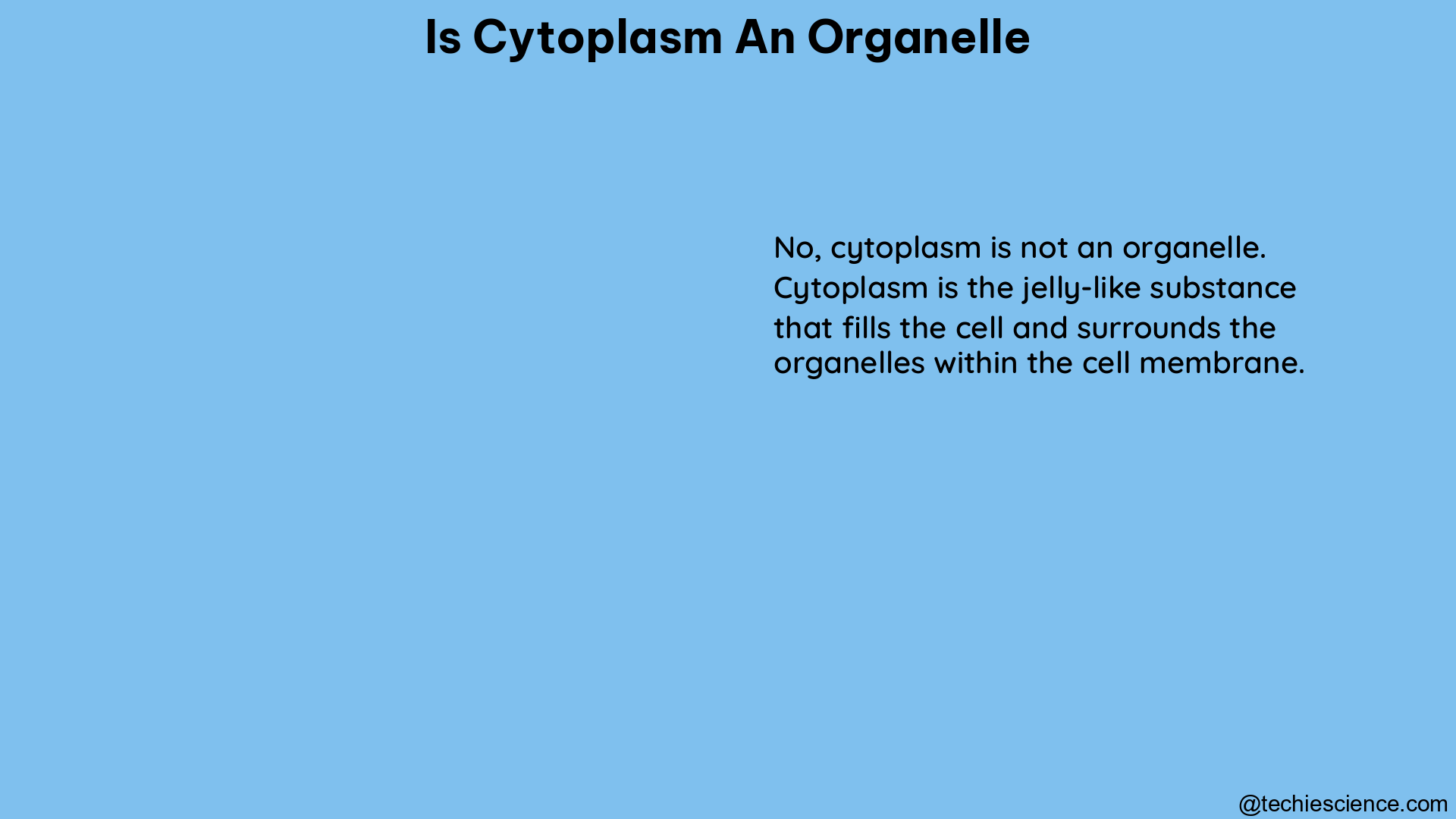Summary
The cytoplasm is not an organelle, but rather the contents of a eukaryotic cell excluding the nucleus and organelles. However, the definition of cytoplasm can vary depending on the context, and some sources may include organelles as part of the cytoplasm. Organelles have distinct properties and functions that are separate from the cytoplasm, as evidenced by studies on quantitative analysis of organelle abundance, morphology, and movement within the cell.
Understanding Cytoplasm and Organelles

The cytoplasm is the gel-like substance that fills the interior of a cell, excluding the nucleus and organelles. It is composed of water, dissolved ions, and a variety of organic molecules, including proteins, lipids, and carbohydrates. The cytoplasm serves as the medium in which the various cellular processes and activities take place.
On the other hand, organelles are specialized structures within the cytoplasm that perform specific functions in the cell. Some of the most well-known organelles include:
- Nucleus: The control center of the cell, containing the genetic material (DNA) and responsible for directing cellular activities.
- Mitochondria: The “powerhouses” of the cell, responsible for generating energy through the process of cellular respiration.
- Endoplasmic Reticulum (ER): A network of interconnected tubules and sacs that play a crucial role in the synthesis, folding, and transport of proteins.
- Golgi Apparatus: Responsible for the processing, packaging, and distribution of proteins and other molecules within the cell.
- Lysosomes: Membrane-bound organelles that contain digestive enzymes and are responsible for the breakdown and recycling of cellular components.
- Peroxisomes: Organelles that play a role in the breakdown of fatty acids and the detoxification of certain substances.
- Ribosomes: Small organelles responsible for the synthesis of proteins.
Distinguishing Cytoplasm from Organelles
While the cytoplasm and organelles are both essential components of a eukaryotic cell, they are distinct entities with different properties and functions.
Morphological Characteristics
According to a study on quantitative analysis of organelle abundance and morphology, the morphological characteristics of cell organelles are important for their function in the cell. This suggests that organelles have distinct physical properties that set them apart from the cytoplasm.
For example, mitochondria have a unique double-membrane structure, with an outer membrane and an inner membrane that is highly folded to increase the surface area for the process of cellular respiration. Lysosomes, on the other hand, have a single membrane and contain a variety of digestive enzymes.
Functional Specialization
Organelles are specialized structures that perform specific functions within the cell, such as energy production, protein synthesis, and waste disposal. In contrast, the cytoplasm serves as the medium in which these cellular processes take place, but it does not have a specialized function on its own.
For instance, mitochondria are responsible for generating ATP, the primary energy currency of the cell, through the process of oxidative phosphorylation. Ribosomes, on the other hand, are responsible for the synthesis of proteins, which are essential for the structure and function of the cell.
Cytoplasmic Streaming
Cytoplasmic streaming is the movement of actin, organelles, and the fluidic cytoplasm in a coordinated pattern. This process involves the movement of organelles within the cytoplasm, further highlighting the distinction between the two.
The movement of organelles, such as mitochondria and vesicles, is facilitated by the cytoskeleton, a network of protein filaments that provide structural support and facilitate intracellular transport. This movement is essential for the distribution of cellular components and the coordination of various cellular processes.
Quantitative Analysis
Automated segmentation and quantitative analysis of organelle shape, size, and location within the cell is an important tool in studying cell biology. This process involves distinguishing between organelles and the cytoplasm, again indicating that they are separate entities.
Researchers have developed advanced imaging techniques, such as fluorescence microscopy and electron microscopy, to visualize and analyze the morphology and distribution of organelles within the cell. By quantifying the size, shape, and spatial arrangement of organelles, scientists can gain insights into their function and the overall organization of the cell.
Conclusion
In summary, while the definition of cytoplasm can vary, it is generally accepted that organelles are not part of the cytoplasm. Instead, organelles have distinct properties and functions that are separate from the cytoplasm. Quantitative analysis of organelle abundance, morphology, and movement within the cell further highlights this distinction, making it clear that cytoplasm and organelles are distinct components of a eukaryotic cell.
References
- Does the cytoplasm include the organelles?
- Quantitative analysis of organelle abundance and morphology
- Cytoplasmic streaming
- Automated segmentation and quantitative analysis of organelle shape, size, and location

Hi, I am Milanckona Das and pursuing my M. Tech in Biotechnology from Heritage Institute of Technology. I have a unique passion for the research field. I am working in Lambdageeks as a subject matter expert in biotechnology.
LinkedIn profile link-